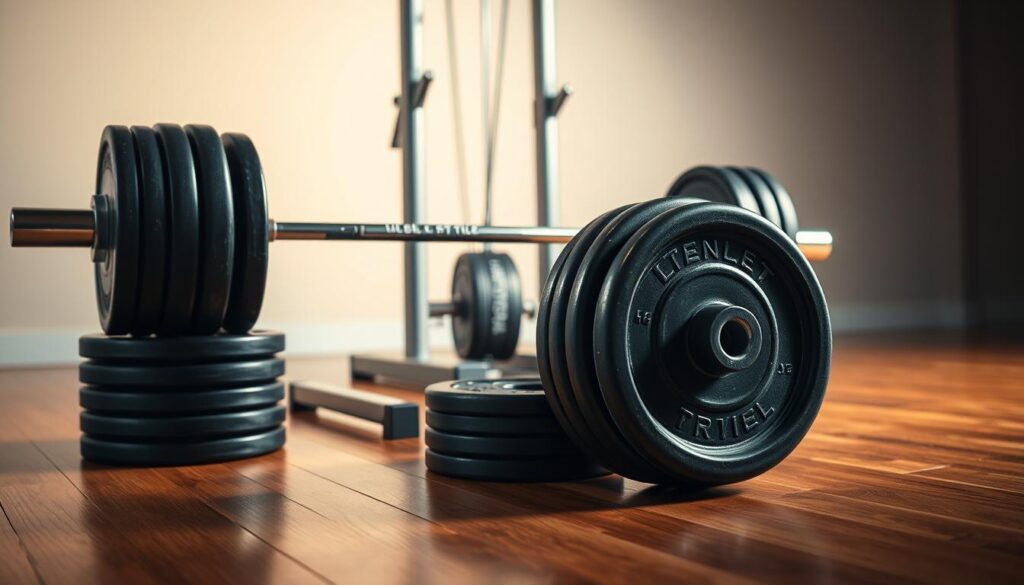You’ve probably heard it before: “Just eat more, and you’ll gain weight.” But what if you’re already eating enough, and the scale still won’t budge? I remember staring at my reflection years ago, frustrated by my inability to add muscle despite endless meals. The truth? Without the right strategy, extra calories alone won’t transform your physique—they’ll just leave you feeling stuck.
Building muscle isn’t about random gym sessions or eating whatever’s in sight. It’s a science. Resistance training acts like a signal to your body, telling it exactly where to use those extra nutrients. Think of it as a blueprint: without structure, progress stays hidden.
This isn’t just lifting weights. It’s about progressive overload—slowly increasing demands on your muscles so they adapt and grow. Pair this with balanced nutrition, and suddenly, your efforts start working with your body instead of against it.
Key Takeaways
- Resistance training is essential for turning calories into muscle, not fat.
- Progressive overload ensures your muscles keep growing over time.
- Consistency matters more than intensity in early stages.
- Your appetite naturally increases with structured workouts.
- Tailor your plan to your current fitness level for sustainable results.
Understanding the Importance of a Workout Plan for Weight Gain
A well-structured routine transforms effort into measurable muscle growth. Without clear direction, even consistent gym visits often lead to frustration. Think of your plan as a roadmap—it tells your body exactly where to invest those extra calories.
Benefits of a Structured Routine
Systematic training creates predictable progress. Research shows hitting each muscle group 2-3 times weekly sparks adaptation. This frequency prevents plateaus and builds momentum over time.
Beginners thrive on consistency. Sporadic sessions confuse muscles, while planned workouts signal growth. You’ll also:
- Track progress through defined benchmarks
- Avoid overtraining specific areas
- Develop sustainable gym habits
The Role of Nutrition and Exercise Synergy
Lifting weights tears muscle fibers. Your diet repairs them—stronger. Without enough protein and calories, recovery stalls. Studies reveal athletes consuming 1.6g protein per kg bodyweight gain lean mass faster.
Timing matters too. Eating carb-rich meals 2 hours before training fuels intense sessions. Post-workout protein shakes accelerate repair. This partnership turns sweat into visible results.
Key Principles of Strength Training for Muscle Growth
Your muscles adapt quickly, turning yesterday’s challenge into today’s routine. To spark continuous growth, you need strategies that outpace your body’s ability to adjust. This requires mastering two core concepts: systematic progression and movement diversity.
Progressive Overload and Exercise Variation
Progressive overload isn’t optional—it’s the engine driving muscle development. Start by adding 2.5-5 lbs to lifts weekly or squeezing out one extra rep per set. Your nervous system adapts faster than muscle fibers, so small, consistent increases matter most.
Change exercises every 4-6 weeks. Rotate between dumbbell bench presses and barbell variations, for example. This prevents adaptation while targeting muscles from new angles. “Variety isn’t randomness—it’s strategic evolution,” notes certified strength coach Liam Parker.
Compound vs. Isolation Movements
Compound exercises like deadlifts engage multiple joints, building functional strength and hormonal responses that boost growth. Prioritize these early in sessions when energy peaks. A study in the Journal of Sports Science found lifters gained 30% more muscle using compound lifts as foundation.
Isolation moves like bicep curls fix imbalances. Use them after primary lifts to exhaust specific muscles. This combination creates balanced development without sacrificing efficiency.
How to Design a Workout Plan for Weight Gain
The foundation of any successful transformation begins with clarity. Knowing exactly what you want to achieve shapes every rep, set, and meal. Without this focus, effort becomes scattered—like trying to hit a target in the dark.
Defining Your Fitness Goals
Specific objectives create measurable outcomes. Are you chasing raw strength to lift heavier weights? Or aiming for visible muscle growth? Your answer determines whether you’ll prioritize 5-rep max attempts or 10-rep hypertrophy sets.
Research shows lifters with written goals achieve 30% better results. Write yours down: “Increase bench press by 20 pounds in 12 weeks” beats vague wishes like “get stronger.” This precision informs exercise choices and recovery strategies.
Selecting the Right Exercises
Your equipment and experience dictate options. Beginners thrive on foundational moves like squats and rows—they build functional strength while teaching proper form. Advanced lifters might add isolation work to target stubborn muscle groups.
“Stick to exercises you can perform safely for years, not just weeks,” advises physical therapist Dr. Elena Torres. Choose 6-8 core movements that cover all major muscles. Rotate variations every month to prevent adaptation while maintaining progress.
Choosing the Best Workout Split to Match Your Goals
Your schedule dictates your success in the gym more than you might realize. The right training split aligns your available days with recovery needs while maximizing muscle stimulation. Three proven frameworks dominate strength programs—each thrives under specific conditions.

Total-Body Sessions vs. Split Routines
Total-body workouts challenge multiple muscle groups per session. You’ll lift 2-3 days weekly, ideal for beginners or time-crunched schedules. This approach builds foundational strength but limits volume per muscle.
Split routines divide focus across days. Advanced lifters benefit from 4-6 weekly sessions targeting specific areas. More frequent training demands stricter recovery protocols but accelerates growth.
Evaluating Push/Pull/Legs and Upper/Lower Options
Push/pull/legs splits organize workouts by movement patterns. Push days train chest and triceps; pull days hit back and biceps. Legs get dedicated attention—perfect for intermediate lifters prioritizing symmetry.
Upper/lower splits alternate between torso and leg days. Four weekly sessions balance frequency and recovery. Research shows this method boosts strength 18% faster than bro splits for natural athletes.
Choose based on consistency first. A 3-day total-body routine beats an ambitious 6-day split you abandon after two weeks. Match your split to your lifestyle, not Instagram trends.
Optimizing Reps, Sets, and Volume for Muscle Hypertrophy
The science of muscle growth hinges on precise combinations of effort and recovery. Your ability to manipulate training variables determines whether you build strength, endurance, or size. For hypertrophy, specific parameters create the metabolic environment your muscles need to expand.
Determining Ideal Repetition Ranges
8-12 reps per set strikes the perfect balance for hypertrophy. This range maximizes mechanical tension while creating metabolic stress—two key growth triggers. Studies show muscles experience 40% more cellular swelling in this zone compared to lower rep ranges.
Choose weights that challenge you within this window. If you breeze through 12 reps, increase resistance. Struggling before rep 8? Lighten the load. Your last 2-3 reps should feel demanding but achievable with strict form.
Adjusting Volume for Consistent Gains
Start with 3-4 sets per exercise, totaling 10-20 weekly sets per muscle group. This baseline prevents burnout while stimulating adaptation. Increase volume by 5-10% monthly as your capacity improves.
| Training Goal | Rep Range | Sets | Volume Focus |
|---|---|---|---|
| Endurance | 12-20 | 2-3 | High reps, low resistance |
| Hypertrophy | 8-12 | 3-4 | Moderate resistance |
| Strength | 4-6 | 4-5 | Heavy weights |
Monitor progress using a training journal. If gains stall after 6 weeks, adjust either weight or volume—not both. “Progressive overload requires patience,” notes strength coach Rachel Nguyen. Small, consistent increases yield better long-term results than drastic changes.
Balancing Free Weights and Machines for Effective Results
The debate between free weights and machines is as old as gyms themselves. Both tools build strength when used strategically, but each shines in different scenarios. Your success depends on matching equipment choices to your experience level and goals.

When to Choose Guided Movement
Resistance machines lock your body into fixed paths—perfect for beginners learning basic movement patterns. This design reduces injury risks while teaching proper muscle activation. You’ll build confidence before tackling complex exercises.
Advantages of Free Weight Training
Barbells and dumbbells force your muscles to stabilize weights in 3D space. This mimics real-world movements like lifting groceries or moving furniture. Over time, this builds functional strength that transfers beyond the gym.
| Feature | Free Weights | Machines |
|---|---|---|
| Movement Path | Unrestricted | Fixed |
| Stabilization Muscles | Activated | Minimal |
| Injury Risk | Higher (poor form) | Lower |
| Best For | Functional strength | Targeted growth |
Combine both approaches for balanced development. Use machines for isolation work like leg extensions, then switch to squats with barbells. This hybrid approach maximizes muscle engagement while building joint stability.
Scheduling Rest and Recovery for Maximum Gains
Muscles whisper their needs in the quiet hours between workouts. While gym time gets the glory, true growth happens when you step away from the barbell. Ignoring recovery is like planting seeds without watering them—effort wasted.
The Importance of Rest Days
Your body repairs torn fibers during downtime. A 2023 study found lifters taking two weekly rest days gained 27% more muscle mass than those training daily. Space intense sessions 24-48 hours apart—this lets inflammation subside and energy stores refill.
Think of rest days as growth accelerators, not setbacks. “Train hard Monday? Let Tuesday be light cardio or mobility work,” suggests trainer Marco Silva. This rhythm prevents burnout while keeping progress steady.
Strategies for Active Recovery
Active recovery boosts blood flow without strain. Try these between heavy training days:
- 20-minute walks
- Yoga flows focusing on tight areas
- Swimming at 50% effort
Sleep quality matters most. Aim for 7-9 hours nightly—deep sleep stages release growth hormone. Pair this with foam rolling to ease sore muscles. Your next workout will thank you.
Creating a Weekly Routine Tailored to Your Lifestyle
Consistency thrives when your routine respects your life’s rhythm. Early risers might crush morning lifts fueled by overnight fasting, while night owls perform better after work. Your energy peaks and schedule gaps dictate workout timing—not arbitrary fitness trends.
Start by blocking 3-4 weekly sessions matching your natural flow. Use lunch breaks for quick strength circuits if evenings get chaotic. Parents often succeed with home workouts during nap times. The goal? Make training unavoidable yet adaptable.
Pair meal timing with gym hours. Morning exercisers need fast-digesting carbs pre-workout, like bananas or toast. Post-session, prioritize protein within 90 minutes. Desk workers benefit from tracking tools to balance activity with recovery needs.
Life changes demand plan adjustments. Traveling? Swap barbells for resistance bands. Crunch time at work? Reduce volume but maintain intensity. Flexibility prevents burnout while keeping momentum alive. Progress compounds when your strategy evolves with you.
